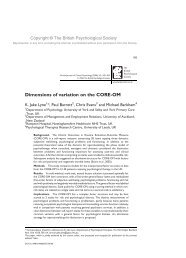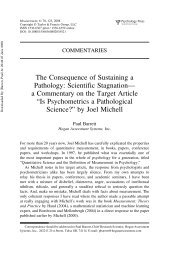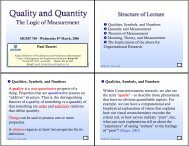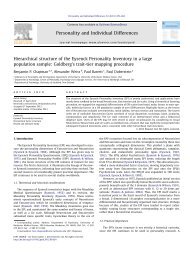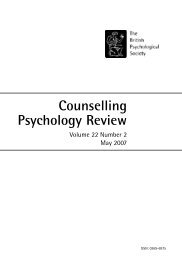Psychophysiological Methods - Paul Barrett
Psychophysiological Methods - Paul Barrett
Psychophysiological Methods - Paul Barrett
- No tags were found...
You also want an ePaper? Increase the reach of your titles
YUMPU automatically turns print PDFs into web optimized ePapers that Google loves.
Breakwell-3389-Reference.qxd 2/7/2006 9:03 PM Page 488Coxon, A. P. M. (1999). Parallel accounts? Discrepancies between self-report (diary)and recall (questionnaire) measures of the same sexual behaviour. AIDS Care, 11,221–234.Crittenden, P. (1998). Truth, error, omission, distortion, and deception: An application ofattachment theory to the assessment and treatment of psychological disorder. InS. M. Clany Dollinger & L. F. DiLalla (Eds), Assessment and intervention issues acrossthe life span. London: Lawrence Erlbaum.Croft, C. A. & Sorrentino, M. C. (1991). Physician interaction with families on issues ofAIDS: What parents and youth indicate they desire. Journal of Health Behavior,Education and Promotion, 15(6), 13–22.Cronbach, L. J. (1951). Coefficient alpha and the internal structure of tests. Psychometrika,16, 297–334.Cronbach, L. J. (1971). Test validation. In R. L. Thorndike (Ed.), Educational measurement.Washington, DC: ACE.Cronbach, L. J., Gleser, G. C., Nanda, H. & Rajaratnam, N. (1972). The dependability ofbehavioral measurements: Theory of generalizability for scores and profiles.New York:Wiley.Crowne, D. P. & Marlowe, D. (1964). The approval motive: Studies in evaluative dependence.New York: Wiley.Dale, A., Gilbert, G. N. & Arber, S. (1985). Integrating women into class theory. Sociology,19, 384–409.Dallos, R. & Draper, R. (2005). An introduction to family therapy (2nd ed.). Maidenhead:Open University Press.Dallos, R. & Vetere, A. (2005). Researching psychotherapy and counselling. Maidenhead:Open University Press.Davies, B. & Harré, R. (1990). Positioning: the discursive production of selves. Journalfor the Theory of Social Behaviour, 20, 43–63.Davies, B. & Harré, R. (1999). Positioning and personhood. In R. Harré & L. vanLangenhove (Eds), Positioning theory. Oxford: Blackwell.Davies, J. B. (2004). Time for a paradigm shift: Bring on the physics revolution. ThePsychologst, 17, 692–693.Davison, M. L. & Sharma, A. R. (1990). Parametric statistics and levels of measurement:factorial designs and multiple regression. Psychological Bulletin, 107, 394–400.de Gruijter, D. N. M. & van der Kamp, L. J. T. (2005). Statistical test theory for educationand psychology. http://icloniis.iclon.leidenuniv.nl/gruijter/De Leuw, E., & Hox, J. (2001). Trends in household survey nonresponse: A longitudinaland international comparison. In R. Groves, D. Dillman, J. Eltinge & R. Little (Eds),Survey nonresponse. New York: Wiley.Delli-Carpini, M. & Williams, B. A. (1994). <strong>Methods</strong>, metaphors and media research: Theuses of TV in political conversation. Communication Research, 21(6), 782–812.Dempster, J. (2001). The laboratory computer: A practical guide for physiologists andneuroscientists. San Diego, CA: Academic Press.Denzin, N. & Lincoln, Y. (2005). The Sage handbook of qualitative research (3rd ed.).Thousand Oaks, CA: Sage.Derrida, J. (1976). Of grammatology (trans. G. Chakravorty Spivak). Baltimore, MD:Johns Hopkins University Press.488 RESEARCH METHODS IN PSYCHOLOGY



